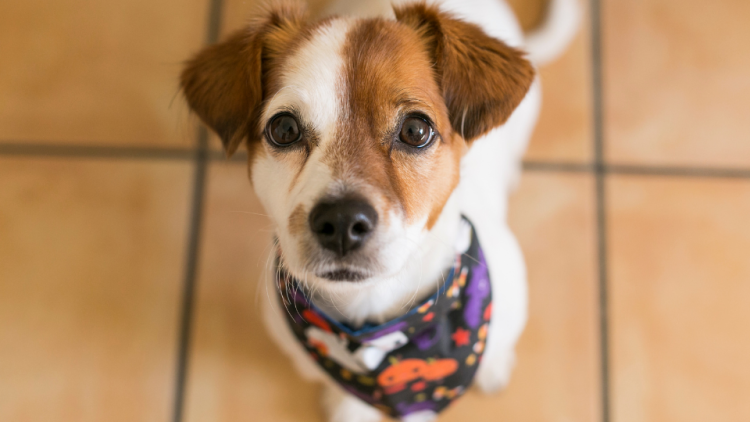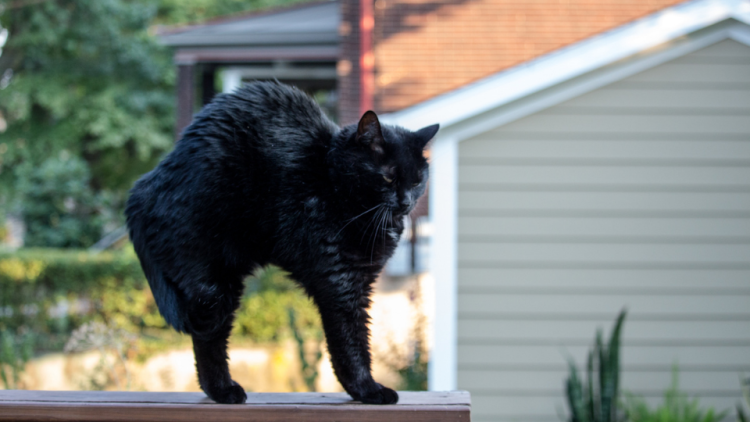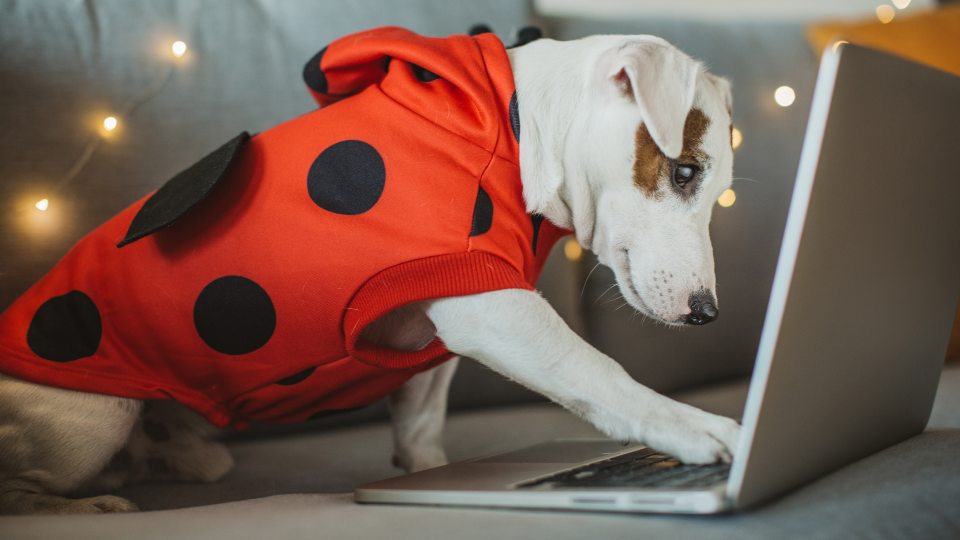Halloween can be great fun for everyone in the family, including our pets. But, as we know, the treats do come with tricks you should be mindful of, so that everyone stays safe well past the night of the 31st.
With respect to our four-legged family members, Halloween can be extra frightening. The holiday often makes pets stressed and can quickly turn into a nightmare for pet parents unless certain precautions are taken.
The accidents that can happen to cats and dogs on 10/31 are scary, so we’ve gathered these five Halloween safety tips for pets to help ensure your night is filled with fun, not fright.
Watch Out For These Halloween Pet Safety Risks:
- Hazardous pet costumes
- Decorations dangerous to pets
- Pet access to Halloween candy
- Stressful environments for pets
- Lost pet indentification
- Key Takeaways
Pro Tip: No matter how careful you may be, accidents and injuries can occur — especially on Halloween. Pet insurance is valuable because it gives pet parents peace of mind knowing that they have access to afforable veterinary care in case anything were to happen.
1. Choose your pet Halloween costume wisely
Maybe your pet enjoys wearing their cat or dog Halloween costume, but most outfits are met with a little (or a lot) of resistance. And though there may be nothing cuter than dogs in Halloween costumes trick-or-treating with the family, or your own little lion romping around the house, there are definitely some risks to be aware of.
Keep these things in mind to ensure your spooky pet stays safe in costume:
- Comfort. Is there enough room in the dog Halloween costume for your pup to breathe? Can your creepy kitty move freely? Remember that outfits should allow for a full range of motion, but not too loose to trip up little paws. Ensure that it doesn’t interfere with their vision, hearing, airway, and mouth opening. Comfort is just as important for our two-legged children as our four-footed fur babies.
- Choke hazards. Some pet costumes may have small parts like buttons or beads that can easily be ripped or chewed off — especially if your pet isn’t a big fan of the ensemble and they try to Houdini their way out of it. Choking (and foreign object ingestion) are very dangerous, so remove all the small, loose accessory pieces and never leave your pet in costume unsupervised.
- Toxicity. Pass on the paints and hair dyes that can be toxic to pets if they (or another pet) were to lick it off their fur or bedding. Glow sticks are highly poisonous to pets and can break easily, so choose LED collars to safely illuminate pets at night.
It’s best to keep cat and dog costumes minimal. Many pet parents choose to keep it simple with a spooky bandana rather than deal with these inherent risks. But if you’re dead set on dressing up your pet, it’s a good idea to get them acclimated with the outfit before Halloween. Watch out for signs of discomfort, which include the tail tucked in, back hunched over, ears folded down, or eyes looking sideways. Never leave costumed pets unattended.

2. Watch out for dangerous decorations
Always consider Halloween pet safety when decorating the house. Just like cat and dog costumes, some items you put up around the house can present serious problems for pets. For example, fake spiders might stir up a cat’s natural hunting instinct, which could end poorly for their stomach if they tried to consume them.
Other potential threats include fake bones (foreign object ingestion), artificial blood (poisonous), rubber eyeballs (choking hazard), cobwebs (entanglement) and loud decorations that may startle pets and cause them to accidentally hurt themselves.
Open flames are another source of concern, as pets are naturally curious and can start a fire by knocking them over. From festive jack-o-lanterns to erie witches’ dens, be sure to keep all candles safely out of reach from pets, including those acrobatic cats known to jump onto tall shelves or tables.
3. Hide the Halloween candy from pets
Many pet parents know that dogs can’t eat chocolate, but it’s even more dangerous if cats eat chocolate. There are other ingredients common in Halloween candy — like xylitol, an artificial sweetener — that are highly toxic in pets. Other treats may be packed with sugar and lead to adverse reactions ranging from mild to severe.
Keep Halloween candy securely stashed where pets can’t access it, and be aware of any plastic packaging leftover around the house that may linger with trace scents of peanut butter, tempting your pet to possibly nibble and choke. Always familiarize yourself with the list of foods dogs can’t eat and foods cats can’t eat that might be included within your holiday spread. For example, small amounts of pumpkin can be great for dogs when served plain, whereas raisins and grapes are highly toxic with potential to cause acute kidney failure or death.
The ASPCA Animal Poison Control Center is available for questions related to possible pet poisoning at (888)426-4435, 24 hours a day, 7 days a week — including holidays like Halloween1.

4. Keep pets safely separated
If you’re planning to have trick-or-treaters on the night of Hallowen, you might consider putting your pets away in a separate room. Otherwise, it could be challenging to keep an eye on them as guests arrive, and there’s a chance they could dart out the door. Even if your pet isn’t traditionally one to bolt when given the chance, many dogs and cats feel distressed by the constant doorbell ringing, which can put them on edge.
They could also get stressed by the presence of strangers in the house — especially if they’re wearing scary masks and costumes. Separating pets into a different part of the house on Halloween might be more pleasant for their experience, and you won’t have to worry about them slipping out and getting lost.
5. Microchip Your Pet
No matter how careful you are, Halloween provides extra opportunities for pets to get loose. Double-check your pet’s ID tags and confirm the contact information is up-to-date. If you haven’t already chipped your pet, now might be a good time. The cost to microchip a dog or cat is very affordable and the procedure is non-invasive.
Microchipping your pet is critical for any pet parent at any time of year, but especially during high-risk occasions like Halloween. It dramatically improves your chances of being reunited with your lost pet by making them identifiable, even if their collar and tag slips off. In fact, it’s estimated that 73% of stray pets found with microchips are reunited with their pet parents2. (For those that aren’t, the main reason is due to incorrect or out-of-date phone numbers).
Key Takeaways
- Stay vigilant to Halloween pet safety hazards found in costumes, candy, and decorations.
- Beware of increased pet anxiety and consider keeping dogs and/cats in a separate part of the house — but be sure to ID them with accurate info, just incase.
- Always supervise pets in case of acccident or injury, but enjoy peace of mind knowing your pet insurance plan can reimburse you for unexpected vet costs.
References
- ASPCA, “Animal Poison Control”. Accessed Oct. 27, 2021.
- Ohio State University, "Microchip Statistics" Accessed Oct. 25, 2021.
